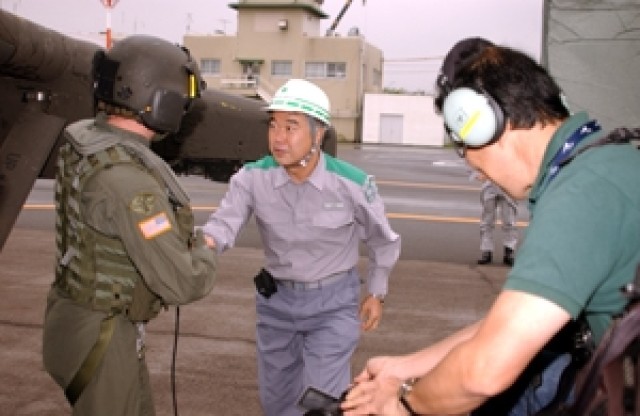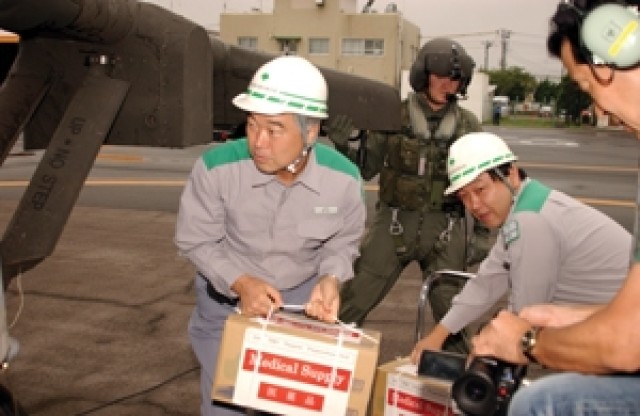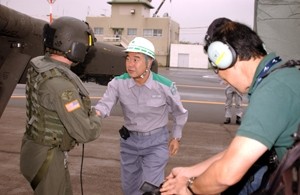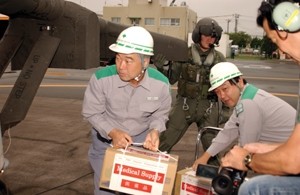An earth shattering 8.3 magnitude quake just struck Tokyo Bay. Buildings all across the city have crumbled, crushing thousands of people and fires are begining to devour what is left of the massive Tokyo metropolitan area. The flames have trapped hundreds of thousands in the inferno and ruptured water lines are preventing the suppression of the fires. Emergency medical supplies are needed immediately to aid the wounded and every second counts.
This scenario may seem far fetched, but it is exactly what happened shortly before noon on Sept. 1, 1923 in what is now known as the Great Kanto Earthquake. The disaster claimed thousands of lives and decimated Tokyo and the surrounding areas.
A Japanese disaster relief worker thanks Staff Sgt. Robert Dahlen of the 78th Aviation Battalio for his efforts during Japan's 2007 National Disaster Prevention Day on Saturday. (U.S. Army photo by Christopher Bush)
Japanese officials conducted the annual National Disaster Prevention Day on Saturday to ensure the city is prepared in the event of another disaster like the 1923 earthquake. In the Tokyo area, more than 20,000 people took part in the exercises.
In an effort to foster good relationships with civil authorities and to develop operational confidence, units from Camp Zama joined more than 200 other prevention organizations during the training.
Capt. James Campbell of the 78th Aviation Battalion of U.S. Army Japan had a major role in the planning and execution of the day's events. Campbell flew his UH 60 Black Hawk helicopter to pick up and deliver mock medical supplies during the drill.
Campbell said the purpose of his unit's involvement in the civil disaster drill was to, "strengthen our relationship with the local people and government" as well as to "exercise our response to a civil disaster."
In light rain and choppy wind, Campbell and his Black Hawk crew flew in the early morning hours from Camp Zama to the Tokyo Metropolitan Heliport to pick up boxes of medical supplies. Yet the adverse weather conditions were not considered a severe impediment for the crew.
"The less than ideal weather for flying added realism to the exercise," Campbell said. "You have to consider the effects of weather on the relief aircraft because that can have a huge impact on the mission."
After loading and securing the supplies aboard the helicopter the crew quickly made their way to Tokyo's Akasaka Press Center in the middle of Tokyo where civil disaster relief workers loaded additional relief supplies.
After just minutes on the ground at the press center, the aircraft lifted into the cloudy skies and headed for nearby Yokota Air Base. Upon arrival at Yokota, the Black Hawk crew handed the boxes off to dozens of relief workers from the Tokyo Metrolpolitan Government.
The entire flight operation was complete within a couple of hours, but it took weeks of planning to fine tune and choreograph each movement of the operation.
"Because there were so many entities involved in the exercise, there is a lot of coordination between the TMG, U.S. Forces Japan, and U.S. Army Japan," Campbell said. "The TMG also had to coordinate with the Tokyo Fire Department, Police Department, Government of Japan, and with the U.S. and all other embassies in Tokyo."
Campbell said he attended several meetings with local government officials at Tokyo's disaster response center in Shinjuku and even conducted a rehearsal flight into the Tokyo Heliport.
"We were the first U.S. helicopter to land at the Tokyo Heliport so we felt it was important to go there and acquaint ourselves with the facility prior to the exercise," Campbell said.
Campbell also said he felt the day was a complete success despite the weather conditions because he felt conducting these types of operations are extremely important.
"The U.S. military has been called upon to respond to civil disasters around the world, and at home in the United States. Those situations rely heavily upon helicopter support to move rescuers, equipment, relief supplies, and evacuees in areas where the infrastructure is either destroyed or impeded by evacuating traffic," he said.
Kanako Sakai of the TMG said the drills were a "great success" that could not have been accomplished without the assistance of the personnel from the 78th Avn. Bn.
"The Tokyo Metropolitan Government is convinced that the drills deepened the trust and friendship between us," Sakai said.




Social Sharing